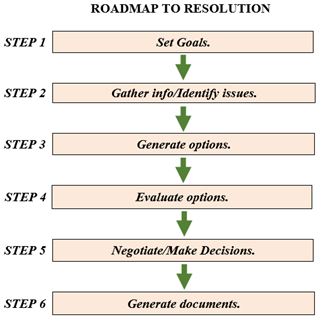
Your divorce, regardless of process will not be free. While a free divorce is impossible you can self manage many of the costs of your divorce. In my work as a
financial neutral working with couples and individuals going through divorce there are five key tips I have observed that can help clients reduce the financial and emotional costs of divorce.
Do everything possible to minimize conflict with your spouse
Divorce is not without conflict. Conflict is expensive. The greater the conflict between you and your spouse the more your divorce will cost in terms of money and in terms of emotional wear and tear. If you and your spouse can openly and respectfully discuss what you can agree to and seek help to work through the issues where you have differing opinions the financial and emotional costs can be reduced. You will save money and time when you put your heads together to resolve your differences instead of butting them against each other.
Get organized and be prepared
If possible, work together with your spouse to gather all financial records necessary for any divorce process. This includes but is not limited to statement copies for everything you own and everything you owe to someone, tax returns including W-2’s, paycheck stubs, bank accounts, credit card accounts, retirement accounts, other investment accounts, insurance information, mortgage and other loans, and information concerning employer provided benefits. Consider putting together a 3-ring binder or electronic file folders containing each of these items. Your divorce decree requires the itemization of every asset and liability. It is foolish, costly, and to your detriment to not be fully open and transparent with your spouse. Being organized, open and completely transparent will help reduce costs.
Establish and communicate expectations
Communicate clearly with the professionals you are working with while at the same time listening carefully to the professionals you do engage. Consider this a two-way dialogue and recognize that you probably do not know what you do not know. Your divorce professionals have the expertise and wisdom to guide you through this difficult time. The wise professionals want to do this in a timely and cost effective manner. Beware of the so-called professionals who promise to get you the best deal. Best deals come at a price both financially and emotionally.
Identify your needs and interests, and those of your spouse
Whenever possible discuss these with your spouse in an open and respectful manner recognizing each of you will have unique needs and interests. You and your spouse will also have shared needs and interests. Needs and interests are not positions. Needs and interests are the underlying reasons and factors why something may be so important to you or your spouse. A position is more like a demand or a must have without stating any particular reasons. If your spouse seems locked into a position, ask them why this particular issue is so important to them and listen carefully for the underlying reasons. If you can find a way to satisfy those reasons, you are on the road to resolution.
Collaborate, compromise, and cooperate
Ask yourself, if you make every decision a battlefield how do you think your spouse will respond. Drawing lines in the sand will only isolate you and make it harder to reach agreements not to mention cost a lot more money and take more time. Remember you got married together and you and your spouse will get divorced together one way or the other. You and your spouse get to choose how.
Every divorce and family is unique and comes with its own set of circumstances. The complexity of the relational, financial, and legal issues of your divorce along with the ability of you and your spouse to follow these five tips will ultimately determine how long your divorce will take and how much it will cost.
Choose your process and your professionals wisely. Check out
this link to learn more and find out if a collaborative divorce is right for you. For more information and resources check out my website under the about us section at
www.integrashieldfinancial.com. There you will find a video featuring actual collaborative divorce process clients, a divorce knowledge kit, resources for those with children, and a link labeled Collaborative Divorce with Dignity and Respect.
 With the recent warm weather and longer days, it is beginning to feel like Spring.
Spring is a time of rejuvenation and growth. As the sun comes out and the temperatures rise, flowers blossom and buds sprout. People are out exercising and enjoying the warm weather. After a long, cold winter, as the days get longer, the community collectively is re-emerging. It is an optimistic, forward-looking time.
There are a number of similarities to Springtime and the re-emergence after a divorce. When someone initiates a divorce, it often causes the fear and negative emotions to increase. There is added anxiety in the process, knowing that you have started but not yet really resolved anything. The divorce itself may feel like winter. You may feel isolated to stuck in a lonely process. You may have a hard time appreciating the positive things in your life and instead focus on the cold, scary parts.
But once resolutions are found, it is a new beginning. Indeed, a collaborative divorce process (where both clients work together out-of-court on resolutions) can lead to meaningful resolutions that establish a great foundation for the future. Mutually acceptable resolutions and a process that supports and nurtures both spouses, can lead to a new normal. Once in place, those resolutions can feel like a whole new life. Like Spring, it can feel like the future is positive and there is potential for emotional and financial success. Relationships can feel refreshed or reinvigorated. People may have better mental health and feel good about moving forward. Like an extra bounce in your step or deeper peace — re-emerging from divorce has great possibility.
There are options when you are divorcing. The collaborative process is a truly future-focused process that supports you during the process and then sets you up for success afterwards. So, if you are contemplating divorce, know that it gets better. There is a springtime waiting for you.
With the recent warm weather and longer days, it is beginning to feel like Spring.
Spring is a time of rejuvenation and growth. As the sun comes out and the temperatures rise, flowers blossom and buds sprout. People are out exercising and enjoying the warm weather. After a long, cold winter, as the days get longer, the community collectively is re-emerging. It is an optimistic, forward-looking time.
There are a number of similarities to Springtime and the re-emergence after a divorce. When someone initiates a divorce, it often causes the fear and negative emotions to increase. There is added anxiety in the process, knowing that you have started but not yet really resolved anything. The divorce itself may feel like winter. You may feel isolated to stuck in a lonely process. You may have a hard time appreciating the positive things in your life and instead focus on the cold, scary parts.
But once resolutions are found, it is a new beginning. Indeed, a collaborative divorce process (where both clients work together out-of-court on resolutions) can lead to meaningful resolutions that establish a great foundation for the future. Mutually acceptable resolutions and a process that supports and nurtures both spouses, can lead to a new normal. Once in place, those resolutions can feel like a whole new life. Like Spring, it can feel like the future is positive and there is potential for emotional and financial success. Relationships can feel refreshed or reinvigorated. People may have better mental health and feel good about moving forward. Like an extra bounce in your step or deeper peace — re-emerging from divorce has great possibility.
There are options when you are divorcing. The collaborative process is a truly future-focused process that supports you during the process and then sets you up for success afterwards. So, if you are contemplating divorce, know that it gets better. There is a springtime waiting for you.  With the recent warm weather and longer days, it is beginning to feel like Spring.
Spring is a time of rejuvenation and growth. As the sun comes out and the temperatures rise, flowers blossom and buds sprout. People are out exercising and enjoying the warm weather. After a long, cold winter, as the days get longer, the community collectively is re-emerging. It is an optimistic, forward-looking time.
There are a number of similarities to Springtime and the re-emergence after a divorce. When someone initiates a divorce, it often causes the fear and negative emotions to increase. There is added anxiety in the process, knowing that you have started but not yet really resolved anything. The divorce itself may feel like winter. You may feel isolated to stuck in a lonely process. You may have a hard time appreciating the positive things in your life and instead focus on the cold, scary parts.
But once resolutions are found, it is a new beginning. Indeed, a collaborative divorce process (where both clients work together out-of-court on resolutions) can lead to meaningful resolutions that establish a great foundation for the future. Mutually acceptable resolutions and a process that supports and nurtures both spouses, can lead to a new normal. Once in place, those resolutions can feel like a whole new life. Like Spring, it can feel like the future is positive and there is potential for emotional and financial success. Relationships can feel refreshed or reinvigorated. People may have better mental health and feel good about moving forward. Like an extra bounce in your step or deeper peace — re-emerging from divorce has great possibility.
There are options when you are divorcing. The collaborative process is a truly future-focused process that supports you during the process and then sets you up for success afterwards. So, if you are contemplating divorce, know that it gets better. There is a springtime waiting for you.
With the recent warm weather and longer days, it is beginning to feel like Spring.
Spring is a time of rejuvenation and growth. As the sun comes out and the temperatures rise, flowers blossom and buds sprout. People are out exercising and enjoying the warm weather. After a long, cold winter, as the days get longer, the community collectively is re-emerging. It is an optimistic, forward-looking time.
There are a number of similarities to Springtime and the re-emergence after a divorce. When someone initiates a divorce, it often causes the fear and negative emotions to increase. There is added anxiety in the process, knowing that you have started but not yet really resolved anything. The divorce itself may feel like winter. You may feel isolated to stuck in a lonely process. You may have a hard time appreciating the positive things in your life and instead focus on the cold, scary parts.
But once resolutions are found, it is a new beginning. Indeed, a collaborative divorce process (where both clients work together out-of-court on resolutions) can lead to meaningful resolutions that establish a great foundation for the future. Mutually acceptable resolutions and a process that supports and nurtures both spouses, can lead to a new normal. Once in place, those resolutions can feel like a whole new life. Like Spring, it can feel like the future is positive and there is potential for emotional and financial success. Relationships can feel refreshed or reinvigorated. People may have better mental health and feel good about moving forward. Like an extra bounce in your step or deeper peace — re-emerging from divorce has great possibility.
There are options when you are divorcing. The collaborative process is a truly future-focused process that supports you during the process and then sets you up for success afterwards. So, if you are contemplating divorce, know that it gets better. There is a springtime waiting for you. 





 A strategy used by some divorcing spouses and their attorneys is to threaten that they will take the other spouse to court. Threatening court is a negotiation strategy in an effort to get the other side to give up or significantly compromise their position(s).
When attorneys use this tactic, they often will prepare for a trial. The trial preparation ends up being extremely expensive and emotionally exhausting for the involved spouses. Often a hatred for the other spouse develops because of trials and/or the threatened use of court.
The reality is a small fraction of divorces end up in trial. The overwhelming reason those cases do end up in trial is because spouses and their attorneys refuse to negotiate. Sometimes a spouse will tell their attorney to go for the throat or they say I want to make him/her pay. It is the divorcing spouses and unfortunately their children, if any, that end up paying the price financially and emotionally. Seeking revenge does not have a place in any divorce process and accompanied by an unwillingness to negotiate in good faith sets up a strategy to fail.
A strategy used by some divorcing spouses and their attorneys is to threaten that they will take the other spouse to court. Threatening court is a negotiation strategy in an effort to get the other side to give up or significantly compromise their position(s).
When attorneys use this tactic, they often will prepare for a trial. The trial preparation ends up being extremely expensive and emotionally exhausting for the involved spouses. Often a hatred for the other spouse develops because of trials and/or the threatened use of court.
The reality is a small fraction of divorces end up in trial. The overwhelming reason those cases do end up in trial is because spouses and their attorneys refuse to negotiate. Sometimes a spouse will tell their attorney to go for the throat or they say I want to make him/her pay. It is the divorcing spouses and unfortunately their children, if any, that end up paying the price financially and emotionally. Seeking revenge does not have a place in any divorce process and accompanied by an unwillingness to negotiate in good faith sets up a strategy to fail.
 Understanding the difference between interests and positions could make all of the difference in helping you negotiate a better outcome in your divorce.
Position-Based Bargaining: Most people have a tendency to negotiate by arguing in favor of their positions. In divorce, this type of “position-based” bargaining can actually make it more difficult to get what you want. Once you and your spouse become locked into positions, the need to defend those positions can lead to a lengthy and expensive divorce. Often position based negotiations come to an end only after both parties have reached a point of physical and emotional exhaustion only to reach a “meet in the middle” agreement. One of the many problems with meeting in “the middle” is that the best solutions may have existed outside of either position. Creative negotiation that avoid positions and focus on interests can lead to outcomes that are better for both parties.
Interest-Based Bargaining: In divorce, couples start by determining their interests and look for true “win/win” scenarios. In order to appreciate how interest-based bargaining works, it is important to understand the difference between positions and interests.
Positions are narrow; “win/lose” proposals can only be satisfied in one way. For example, statements such as “I want Sole custody” or “I need $5,000 per month in support” or “I must have the house” represent positions that require the other person to “lose” in order for you to win. On the other hand, “interests” (sometimes called goals) focus on big picture desires that can be satisfied in many ways. Statements such as “I want our children to be kept out of the conflict” or “I want financial stability for both homes” or “I want us to be able to communicate better in our co-parenting” are requests to have an important interest met.
One of the advantages of focusing on big-picture interests is that you and your spouse are likely to have many of these interests in common. Therefore, although working on the details of how these interests can be met will still require some problem solving skills (and some bargaining) the negotiation becomes easier because you are both working toward these important common goals.
Interest-based bargaining is a skill that needs to be developed over time. Divorce negotiations are usually improved when the professionals involved have significant training and experience in this method so that they can teach these skills to their clients. Most mediators and Collaborative professionals have training and experience in interest based bargaining. To locate a professional who understands this method to interview and to learn more about interest based divorce negotiation go to
Understanding the difference between interests and positions could make all of the difference in helping you negotiate a better outcome in your divorce.
Position-Based Bargaining: Most people have a tendency to negotiate by arguing in favor of their positions. In divorce, this type of “position-based” bargaining can actually make it more difficult to get what you want. Once you and your spouse become locked into positions, the need to defend those positions can lead to a lengthy and expensive divorce. Often position based negotiations come to an end only after both parties have reached a point of physical and emotional exhaustion only to reach a “meet in the middle” agreement. One of the many problems with meeting in “the middle” is that the best solutions may have existed outside of either position. Creative negotiation that avoid positions and focus on interests can lead to outcomes that are better for both parties.
Interest-Based Bargaining: In divorce, couples start by determining their interests and look for true “win/win” scenarios. In order to appreciate how interest-based bargaining works, it is important to understand the difference between positions and interests.
Positions are narrow; “win/lose” proposals can only be satisfied in one way. For example, statements such as “I want Sole custody” or “I need $5,000 per month in support” or “I must have the house” represent positions that require the other person to “lose” in order for you to win. On the other hand, “interests” (sometimes called goals) focus on big picture desires that can be satisfied in many ways. Statements such as “I want our children to be kept out of the conflict” or “I want financial stability for both homes” or “I want us to be able to communicate better in our co-parenting” are requests to have an important interest met.
One of the advantages of focusing on big-picture interests is that you and your spouse are likely to have many of these interests in common. Therefore, although working on the details of how these interests can be met will still require some problem solving skills (and some bargaining) the negotiation becomes easier because you are both working toward these important common goals.
Interest-based bargaining is a skill that needs to be developed over time. Divorce negotiations are usually improved when the professionals involved have significant training and experience in this method so that they can teach these skills to their clients. Most mediators and Collaborative professionals have training and experience in interest based bargaining. To locate a professional who understands this method to interview and to learn more about interest based divorce negotiation go to  Your divorce, regardless of process will not be free. While a free divorce is impossible you can self manage many of the costs of your divorce. In my work as a
Your divorce, regardless of process will not be free. While a free divorce is impossible you can self manage many of the costs of your divorce. In my work as a